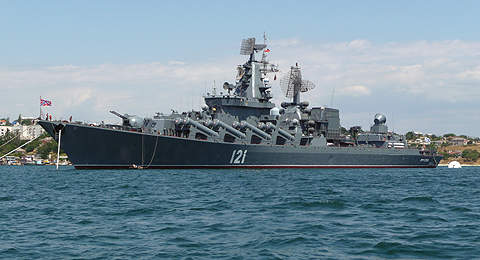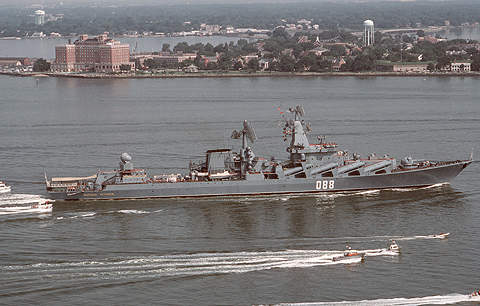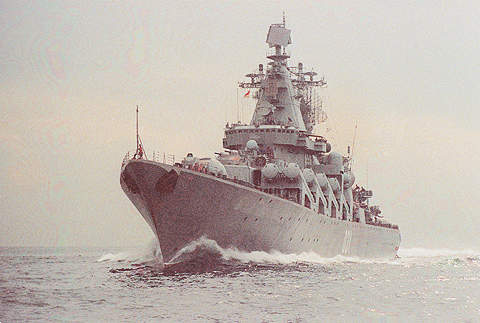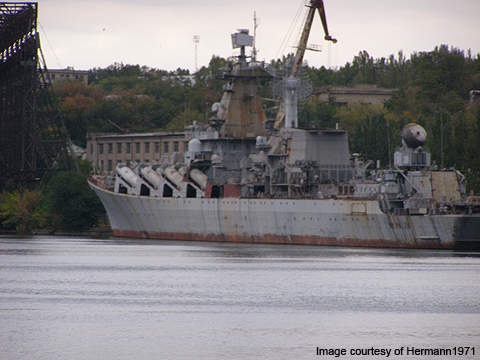The Russian Navy operates three cruisers while Ukraine owns an incomplete ship. Developed as surface strike ships, the Slava Class demonstrates anti-air and anti-submarine warfare (ASW) capabilities.
The first cruiser in the class, Slava, was commissioned in January 1983. It was renamed Moskva in 1995. The second vessel, Marshal Ustinov (formerly Admiral Lobov), was commissioned in 1986 and the third ship, Varyag, was commissioned in 1989. The fourth vessel of the class, Ukrayina, was launched in 1990 and was never commissioned. Remaining cruisers in the class, Oktyabrskaya Revolutsiya (Rossiya) and Admiral Gorshkov, were cancelled due to lack of funds.
The Slava Class was earlier designated Blackcom 1 (Black Sea Combatant 1) and Krasina Class before it entered into service. The Moskva underwent a major refit during 1990 and re-entered service in the end of 1998. It completed a major overhaul in December 2009 and re-entered service in early 2010.
In May 2010, the Russian Government agreed with Ukraine to provide assistance to complete the construction of Ukrayina.
Slava Class design
Designed as a battle cruiser, the Slava Class is smaller and less expensive than other ships, which demonstrate similar capabilities. The design integrates the P-500 Bazalt missile, which is a conventional alternative to the missiles installed in the Kirov Class battle cruiser. A crane is installed on the ship for handling boats, while anti-ship missiles fitted on either side of the superstructure provide it with a typical appearance. The vessels have poor damage control capabilities due to flammable materials used in the structure.
The Slava Class has an overall length of 186.4m, a beam of 20.8m and a draught of 8.4m. The displacement of the cruiser is 11,490t. The vessel can accommodate 476-529 crew members.
Slava Class missiles
The Slava Class is armed with 16 P-500 Bazalt (SS-N-12 Sandbox) anti-ship missiles, 64 S-300PMU Favorit (SA-N-6 Grumble) long-range surface-to-air missiles and OSA-M (SA-N-4 Gecko) surface-to-air missile system. The system is fitted with a Zif-122 retractable rotating launcher for 9M33M missiles.
Slava Class naval guns
A 130mm twin barrel AK-130 dual-purpose gun is mounted on the vessel, which can fire ten to 40 rounds per minute. There are also six AK-630 close-in weapon systems (CIWS) installed on the ship, which comprises a fully automatic six-barrelled 30mm Gatling gun, fire control radar and electro-optical tracker. The AK-630 CIWS provides self defence against anti-ship missiles and other guided weapons, with a rate of fire of 5,000 rounds per minute.
Anti-submarine warfare
The Slava Class is fitted with two M57 quintuple 533mm torpedo tubes. Anti-submarine systems include two RBU 6000 rocket launchers. The rockets can be launched against submarines within a range of 6km.
Slava Class aircraft
The Slava Class has a helicopter deck to allow the operations of a Kamov Ka-25 or Ka-27 helicopter. The helicopter hangar located under the landing pad is connected through a ramp. The vessel has storage facilities to carry 6t of aviation fuel.
Slava sensors / radars
The sensor suite includes a MR-800 Voshkod / Top Pair, 3D air search radar, MR-700 Fregat / Top Steer 3D air / surface search radar, MG-332 Tigan-2T / Bull Horn hull mounted sonar and Mare Tail variable depth sonar.
Admiral Lobov and Varyag were fitted with a MR-710 Fregat-MA / Top Plate 3D air search radar.
Other systems include Top Dome missile guidance radar, Front Door fire control system and Kite Screech gun control system.
Slava Class propulsion
The Slava Class is equipped with a combined gas or gas (COGOG) propulsion system. Four M8KF gas turbines driving two shafts deliver a total of around 120,000hp, while the propulsion system provides a maximum speed of 32kt. The vessel has a range of 2,500nm at 30kt and a maximum of 6,500nm at 18kt.






